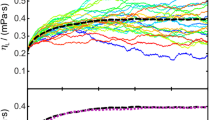Abstract
The effects of solid-fluid interactions on the vapor-liquid phase diagram, coexistence density, relative volatility and vaporization enthalpy have been investigated for confined binary systems of CO2-CH4, CO2-N2 and CH4-N2. The Gibbs ensemble Monte Carlo (GEMC) simulation results indicate that the confinement and the solid-fluid interaction have significant influences on the vapor-liquid equilibrium properties. The confinement and the strength of the solid-fluid interaction make the p-x i phase diagram move to higher pressure regions. They also make the two-phase region become narrower for each binary mixture. The strength of the solid-fluid interactions can cause increases in the coexistence liquid and vapor densities, and cause the decrease of the relative volatility and the vaporization enthalpy for the systems studied. As the pore width is decreased, the two-phase region of the binary mixture becomes narrower.
Similar content being viewed by others
References
Energy information administration, International Energy Outlook 2010. Part A. Global Energy Trends. Washington, DC: US Department of Energy, DECD/IEA, 2010. http://www.eia.gov/oiaf/ieo/index.html accessed on May 17, 2011
Xiao Y, Low B T, Hosseini SS, Chung TS, Paul DR. The strategies of molecular architecture and modification of polyimide-based membranes for CO2 removal from natural gas—A review. Prog Polym Sci, 2009, 34: 561–580
Al-Sahhaf TA, Kidnay AJ, Sloan ED. Liquid + vapor equilibria in the N2+CO2+CH4 system. Ind Eng Chem Fund, 1983, 22: 372–380
Jin ZL, Liu KY, Sheng WW. Vapor-liquid-equilibrium in binary and ternary mixtures of nitrogen, argon, and methane. J Chem Eng Data, 1993, 38: 353–355
Dunne LJ, Furgani A, Jalili S, Manos G. Monte-Carlo simulations of methane/carbon dioxide and ethane/carbon dioxide mixture adsorption in zeolites and comparison with matrix treatment of statistical mechanical lattice model. Chem. Phys, 2009, 359: 27–30
Yu YX. A novel weighted density functional theory for adsorption, fluid-solid interfacial tension, and disjoining properties of simple liquid films on planar solid surfaces. J Chem Phys, 2009, 131: 024704
Bhide BD, Stern SA. Membrane processes for the removal of acid gases from natural-gas .1. Process configurations and optimization of operating-conditions. J Membrane Sci, 1993, 81: 209–237
Tabe-Mohammadi A. A review of the applications of membrane separation technology in natural gas treatment. Sep Sci Technol, 1999, 34: 2095–2111
Ohlrogge K, Keil B, Wind J. Dehydration and hydrocarbon dewpointing of natural gas by membrane technology. Abstr Pap Am Chem S, 2001, 221: U225–U225
Brinkmann T, Wind J, Ohlrogge K. Membrane processes in natural gas processing. Chem Ing Tech, 2003, 75: 1607–1611
Hagg MB, Lindbrathen A. CO2 capture from natural gas fired power plants by using membrane technology. Ind Eng Chem Res, 2005, 44: 7668–7675
Lokhandwala KA, Pinnau I, He ZJ, Amo KD, DaCosta AR, Wijmans JG, Baker RW. Membrane separation of nitrogen from natural gas: A case study from membrane synthesis to commercial deployment. J Membrane Sci, 2010, 346: 270–279
Budinsky R, Vacek V, Lisal M. Vapor-liquid equilibria of alternative refrigerants and their binaries by molecular simulations employing the reaction Gibbs ensemble Monte Carlo method. Fluid Phase Equilib, 2004, 222: 213–220
Carrero-Mantilla J, Llano-Restrepo M. Vapor-liquid equilibria of the binary mixtures nitrogen plus methane, nitrogen plus ethane and nitrogen plus carbon dioxide, and the ternary mixture nitrogen plus methane plus ethane from Gibbs-ensemble molecular simulation. Fluid Phase Equilib, 2003, 208: 155–169
Chang J, Sandler SI. Interatomic Lennard-Jones potentials of linear and branched alkanes calibrated by Gibbs ensemble simulations for vapor-liquid equilibria. J Chem Phys, 2004, 121: 7474–7483
Li YF, Yu YX, Zheng YX, Li JD. Shift of the azeotropic point of binary Lennard-Jones mixtures confined in a slit-like pore. Fluid Phase Equilib, 2010, 292: 110–116
Duan ZH, Moller N, Weare JH. Gibbs ensemble simulations of vapor/liquid equilibrium using the flexible RWK2 water potential. J Phys Chem B, 2004, 108: 20303–20309
Panagiotopoulos AZ, Quirke N, Stapleton M, Tildesley DJ. Phase-equilibria by simulation in the Gibbs ensemble-Alternative derivation, generalization and application to mixture and membrane equilibria. Mol Phys, 1988, 63: 527–545
Li YH, Ma PS, Wang YR. Potential parameter for Lennard-Jones (12-6) potential by gas viscosity. Chem Eng, 2003, 31: 53–56 (in chinese)
Cuadros F, Cachadina I, Ahumada W. Determination of Lennard-Jones interaction parameters using a new procedure. Mol Eng, 1996, 6: 319–325
Tchouar N, Benyettou M, Kadour FO. Thermodynamic, structural and transport properties of Lennard-Jones liquid systems. A molecular dynamics simulations of liquid helium, neon, methane and nitrogen. Int J Mol Sci, 2003, 4: 595–606
Mecke M, Winkelmann J, Fischer J. Molecular dynamics simulation of the liquid-vapor interface: Binary mixtures of Lennard-Jones fluids. J Chem Phys, 1999, 110: 1188–1194
Steele WA. The Interaction of Gases with Solid Surfaces. Oxford: Pergamon Press, 1974
Harismiadis VI, Vorholz J, Panagiotopoulos AZ. Efficient pressure estimation in molecular simulations without evaluating the virial. J Chem Phys, 1996, 105: 8469–8470
Vortler HL, Smith WR. Computer simulation studies of a square-well fluid in a slit pore. Spreading pressure and vapor-liquid phase equilibria using the virtual-parameter-variation method. J Chem Phys, 2000, 112: 5168–5174
Mraw SC, Hwang SC, Kobayashi R. Vapor-Liquid-Equilibrium of CH4-CO2 System at Low-Temperatures. J Chem Eng Data, 1978, 23: 135–139
Author information
Authors and Affiliations
Corresponding author
Electronic supplementary material
Rights and permissions
About this article
Cite this article
Li, Y., Yu, Y., Zheng, Y. et al. Vapor-liquid equilibrium properties for confined binary mixtures involving CO2, CH4, and N2 from Gibbs ensemble Monte Carlo simulations. Sci. China Chem. 55, 1825–1831 (2012). https://doi.org/10.1007/s11426-012-4724-5
Received:
Accepted:
Published:
Issue Date:
DOI: https://doi.org/10.1007/s11426-012-4724-5




